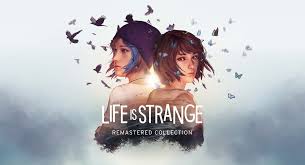Game Information
Name: Life is Strange
Creator: Dontnod Entertainment, published by Square Enix
Platform: PlayStation, Xbox, Switch, IOS, and PC
Target Audience: Ages 17+
For this week’s critical play, I played Episode 1 of Life is Strange on my Mac. In this game, players embody Max Caulfield, a photography student who uncovers her time-traveling ability and navigates life in high school. In the game, players explore a narrative through environments similar to walking simulators, interact with other characters, and make choices that impact the unfolding storyline (centered around Max’s goal to save her best friend Chloe). Through the narrative, we explore themes around gun violence, dugs, suicide, so the age rating is very fitting. The game intertwines predetermined missions/actions with player choices, leading to branching narratives influenced by their decisions, which shape the overarching course of the game’s narrative.
In Life is Strange, the narrative blends mystery seamlessly through its mechanics, giving players a range of choices and outcomes that reflect their decisions. Your position in the game and past choices influence what decisions you can make, making each experience unique. Exploring the environment, examining objects, and talking to characters allow players to uncover the mysteries in the world around them. When the game rewards players by rewinding time, it’s not just about the gameplay – it’s a chance to rewrite the narrative, creating new paths and endings.
Life is Strange’s gameplay and mechanics balance exploration, character interactions, and item inspection into its narrative gameplay. As you navigate through the game’s environment, you’re presented with opportunities to engage in several distinct actions: talking to other characters, observing your surroundings, or using objects to uncover mysteries in the narrative. While all of these may not be available in a given moment, the game guides you towards specific actions to advance the story. In Episode 1, the game begins to introduce these mechanics as you explore a mysterious island in the middle of a storm. As we make our way to a lighthouse that we observe, a massive tornado wrecks the lighthouse. Just as it’s about to topple over Max we wake up and find ourselves in an art class and in the main storyline. Here, I used item inspections and movement to uncover Max’s passion for photography and engage in conversations that begin to unravel interpersonal dynamics of characters.

Like this section of the game, we subsequently explore other sub-arcs in the game that build skills and understanding of the environment, many of which form loops in the game through the time reversal mechanic. These sub-arcs and loops provide contexts for stories and personalities of other characters that add to the mystery of the narrative. For example, in one of these arcs after encountering the principal about what happened in the bathroom, we head back to a dorm room to retrieve a flash-drive. Along the way, we can talk to several other characters which give more insight to issues around the school. In another loop at Chloe’s house, where we’re also able to rewind time, we find out that Chloe is the one putting up posters around the school about a missing girl named Rachel Amber. This was also a poster that we saw on the wall on the way to the bathroom in a previous encounter, showcasing an excellent example of how mysteries are discovered and explored in Life is Strange. In this way, loops in the game advance the overall story while providing us with smaller sub-arcs that raise new questions and mysteries of the game. It’s as if the game is training us on what to look out for, be observant and interact with the environment.

Player choices in Life is Strange have different levels of depth, where less significant decisions have immediate consequences and significant decisions impact the overarching narrative. Due to this mechanic, the game often has branching paths and long-lasting effects. For example, telling on Nathan to the principal will result in him further antagonizing her in the future and Nathan’s father sending a threatening note. These pivotal moments are visually emphasized, characterized by the screen splitting and time freezing, which provides an aesthetic for the significance of shaping the narrative. Despite players having forms of autonomy in the game like decisions, Life is Strange primarily follows a predetermined narrative. However, free-roam exploration, item inspection, and character interactions encourage players to discover clues and explore the game’s mysteries to deepen their understanding of the game’s world.

The use of exploration and item inspection reminds me a lot of What Remains of Edith Finch, guiding the player through its respective narratives. One suggestion for improving the game would be the dialogue options, as I felt that there were times where these moments felt limited or constraining, reducing a sense of agency. Also, having so many interactive elements, while providing context into characters’ stories and personalities, occasionally made the pacing feel slow and blurred what was actually important to the main storyline. So, providing more guidance or indications of objectives could have improved the gameplay experience, especially for those solely interested in advancing the main storyline. However, I found the game’s encouragement of exploration and curiosity fun and fulfilling. Whenever I learned something new or discovered a different part of the story I was engaged and eager to continue exploring.



